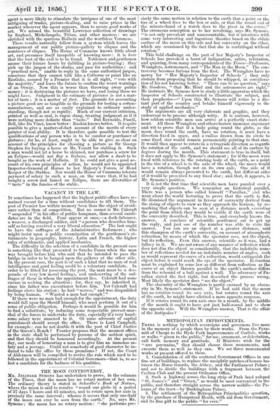THE MOON CONTROVERSY.
Mn. JELINGES SYMONS has undertaken to prove, in the columns of the Times, that the moon has no rotary motion of her own. The ordinary theory is stated in Schcedler's Book of Nature, where the moon is said to revolve "round our globe in a period of 27 days 7 hours and 43 minutes, and to rotate upon her axis in precisely the same interval ; whence it occurs that only one-half of the moon can ever be seen from the earth." No, says Mr. Symons; the moon has no rotary motion : "she performs pre-
cisely the same motion in relation to the earth that a point on the tire of a wheel does to the box or axle, or that the round end of the minute-hand of a watch does to the pivot in the centre." The erroneous conception as to her revolving, says Mr. Symons, "is i not only prevalent and unaccountable, but it interferes with some very interesting and ingenious theories based on the oblate surface of the moon on this side and her convexity on the other, which are occasioned by the fact that she is centrifugal without rotation."
This bold challenge on the part of her Majesty's Inspector of Schools has provoked a burst of indignation, satire, refutation, and quizzing, from many correspondents of the Times—Professors, Wranglers, Astronomers, and The Man in the Moon." The con- troversy, becomes furious from the first. The Wranglers have no mercy for " Her Majesty's Inspector of Schools"; ; they only abstain from proposing that he should be whipped, in considera- tion of his not knowing better. "There can be no question," says Mr. Goodeve, "that Mr. Hind and the astronomers are right." He instructs Mr. Symons how to study a little apparatus which the Inspector of Schools constructed to illustrate the subject, and then prophesies—" Upon this Mr. Symons will retire to a dis- tant part of the country and betake himself vigorously to the study of applied mechanics."
The arguments are all very elaborate and graphic, and they endeavour to be precise although witty. It is curious, however, how seldom scientific men can arrive at a perfectly exact state- ment. All these Wranglers and others bestow immense argument and wit to prove that if a body going round the globe, as the moon does round the earth, have no rotation, it must have a direction fixed in space, and a radius drawn from its circle to some fixed star would remain permanently pointing to that star. It would then appear to rotate in a retrograde direction as regards the rotation of the earth, and we should see all of its surface by degrees during the month. This statement is true in itself, but it does not apply to Mr. Symons's statement ; for if the moon were fixed with reference to the rotating body of the earth, as a point in the tire of a. wheel is to the axle of the wheel, the moon would. have a rotation, though not on its own axle. One side of it would remain always presented to the earth, but different sides of it would be presented to any fixed star ; and that, it appears, is Mr. Symons's position.
It is not the first time that scientific men have puzzled over a very simple question. We remember an historical parallel. There was a person who called himself " Parallax " and who went about the world lecturing to prove that the earth is flat. He dismissed the argument in favour of convexity derived from the rising of objects to view as they approach the horizon, by re- marking that objects can be seen at a distance much exceeding the point from which they would be visible if the earth were of the convexity described. This is true, and everybody knows the answer. A. conclave of soientific gentlemen sat to get up the reply, and just one of the number was able to state the answer. You can see an object at a greater distance, said this champion of the earth's convexity, on account of atmospheric refraction, by means of which the spectator sees, not the object, but its reflection. Even this answer, scientific as it was, had a fallacy in it. We are not aware of any manner of reflection which does not dim the object so considerably, that the indefinite num- ber of reflections needed for an indefinite number of angles, suds as would represent the curve of a refraction, would extinguish the object before it could reach the eye of the spectator. Refraction must be explained by some law as different from reflection as the curve of an object thrown parallel to the earth's surface differs from the rebound of a ball against a wall. The adversary of Pa- rallax stated the fact right, but described the process wrong. Most likely the spectator does "see the object."
The obscurity of the Wranglers is partly excused by an obscu- rity in Mr. Symons's statement. If he had said that the moon has no rotation round its own axis, but rotates round the axis of the earth, he might have elicited a more apposite response. If it rotates round its own axis once in a month, by the middle of the month it ought to have got just, half-round and to show the opposite side. Will the Wranglers answer, That is the affair of the Antipodes ?


























 Previous page
Previous page